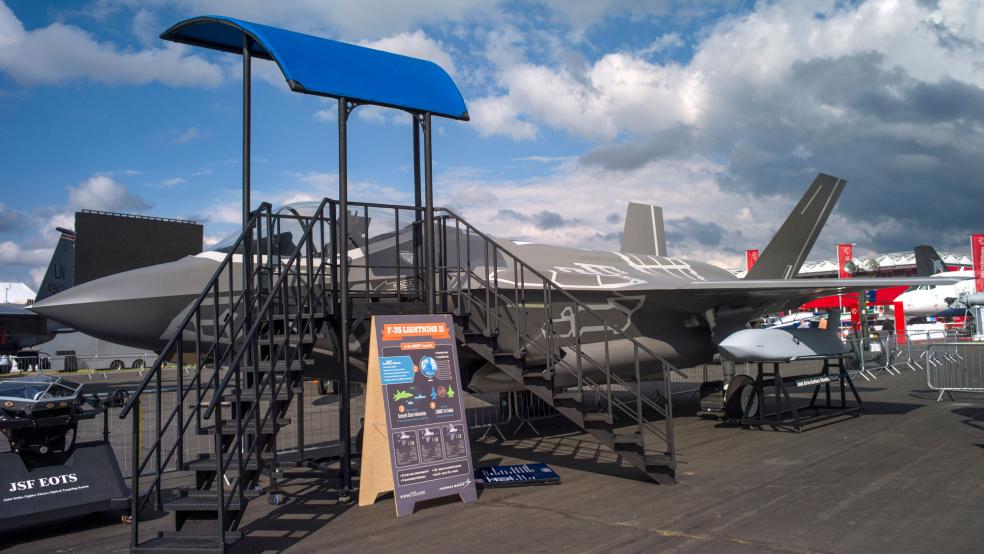The F-35, DOD’s $1.5 trillion dollar fighter jet that’s been besieged by problems, was due to make its much-hyped international debut at the Farnborough air show in the United Kingdom this week. It was supposed to be the first chance for foreign buyers to get a look at the next generation plane, which has already cost the Pentagon $400 billion. More than 3,000 global orders have already been placed.
Those buyers are going to be disappointed. The plane, which has been grounded repeatedly during testing, will not make the trip overseas. A problem in the Pratt & Whitney engine two weeks ago grounded the plane. Pentagon spokesperson Rear Admiral John Kirby said DOD brass decided the plane was not ready for show time on the international stage. A fire in the engine resulted because “blades in the engine’s low-pressure turbine and the surrounding cowl rubbed much more than is acceptable and a blade failed,” Frank Kendall, head of Pentagon acquisition, told reporters.
Related: 719 New Problems for the $1.5 Trillion F-35 Fighter
“I can confirm that the Department of Defense in concert with our partners in the UK has decided not to send Marine Corps and UK F-35B aircraft across the Atlantic to participate in the Farnborough air show,” Kirby said.
Kirby added that the flight restriction placed on the plane two weeks ago had been lifted. However, the engine needs to be checked every three hours to make sure it’s working properly.
“We're actually glad for the news today to get the aircraft back in the air even if it is limited - we fully expect to work our way through this problem and restore the aircraft to full operational capability in the near future,” Kirby said. “While we're disappointed that we're not going to be able to participate in the air show, we remain fully committed to the program itself and look forward to future opportunities to showcase its capabilities to allies and to partners."
This isn’t the first time that the F-35 has missed appearances across the pond. However, the Farnborough showing was hyped as the plane’s formal coming out party to an international audience. Its failure to show is a huge marketing black eye for both the Pentagon and Lockheed Martin, the plane’s manufacturer.
Related: The Pentagon's Incredible $1.5 Trillion Mistake
According to Winslow Wheeler, a defense budget expert and a long-time critic of the F-35 program, there were questions about whether the plane could perform in England, even if the engine problem was resolved.
“Even if the F-35 is released to participate at Farnborough, there may be a new problem: weather predictions for next week in England are not good, and the F-35 has real issues flying near thunder and rainstorms; it even has problems with wet runways,” Wheeler wrote on his blog.
Stuck With It
The F-35 has crossed the point of no return. DOD has invested so much money in it, and so much time, that it’s stuck with it, even if the manufacturing process is a case study on how to mismanage defense projects.
The new engine problem is the latest in a series that have plagued the plane. As Wheeler noted, the plane doesn’t perform well in inclement weather. The cost of the program is $160 billion over initial estimates.
Related: Why the U.S. Has So Much Riding on the F-35
U.S. allies, like America itself, are stuck with the jet. Even though it won’t be on display, countries like Italy, Canada. Australia and Norway are on the hook to purchase around 3,000 planes. Like the Pentagon, these countries have been sucked down the F-35 rabbit hole.
The F-35 conundrum has vexed the Pentagon for years now. Last week, Defense Secretary Chuck Hagel again reiterated that the plane would be DOD’s future fighter jet, despite cost overruns and delays.
“This aircraft is the future of fighter aircraft for all our services,” Hagel said to servicemen gathered in a F-35 hangar in Florida. “The F-35 is as big a project as we have and we’ve got a lot riding on it.”
“I know there are issues, but I don’t know a platform that we’ve ever had, we’ve ever designed, we’ve ever tried and then put into service that didn’t go through issues,” Hagel added.
Top Reads from The Fiscal Times:


